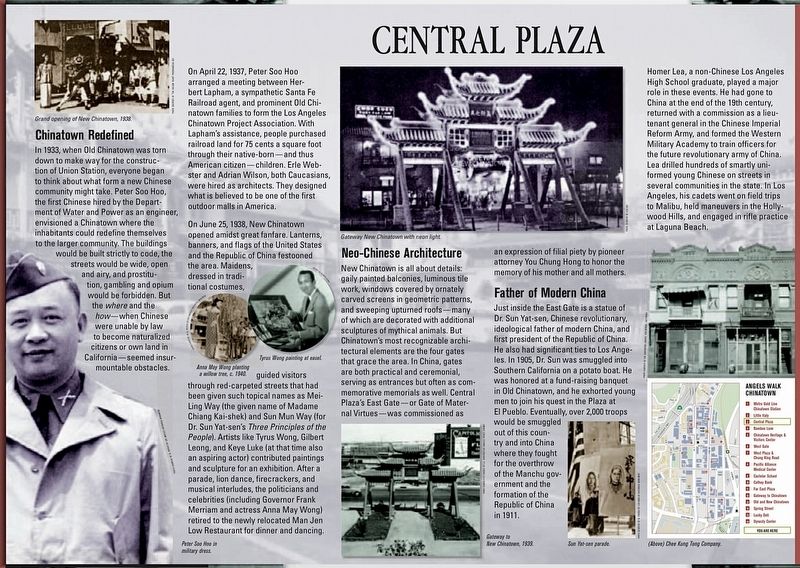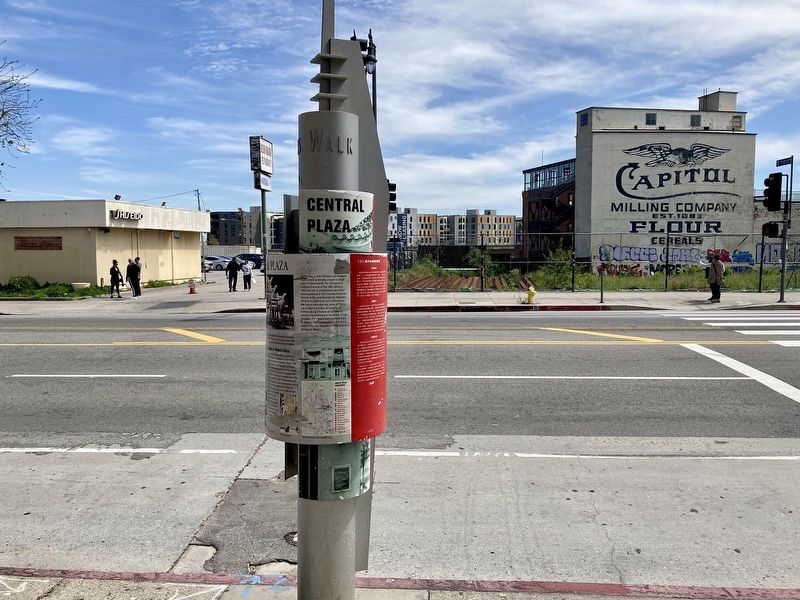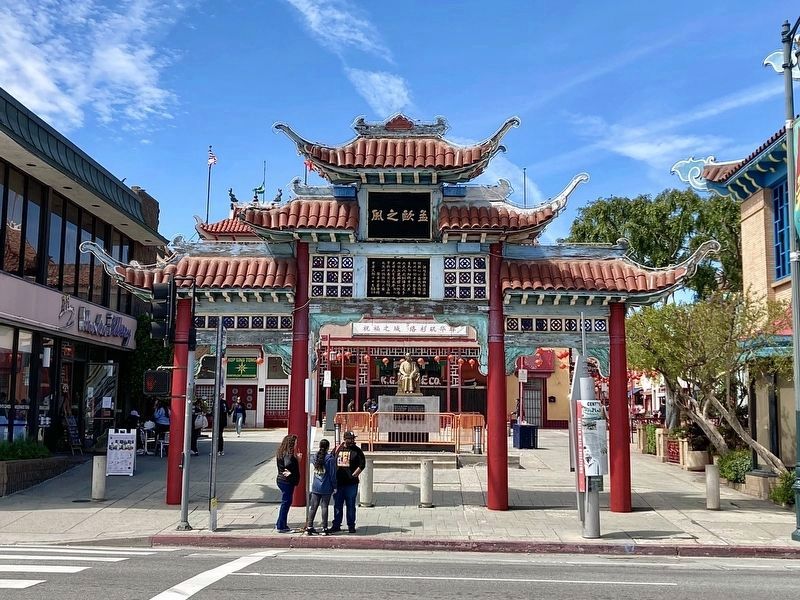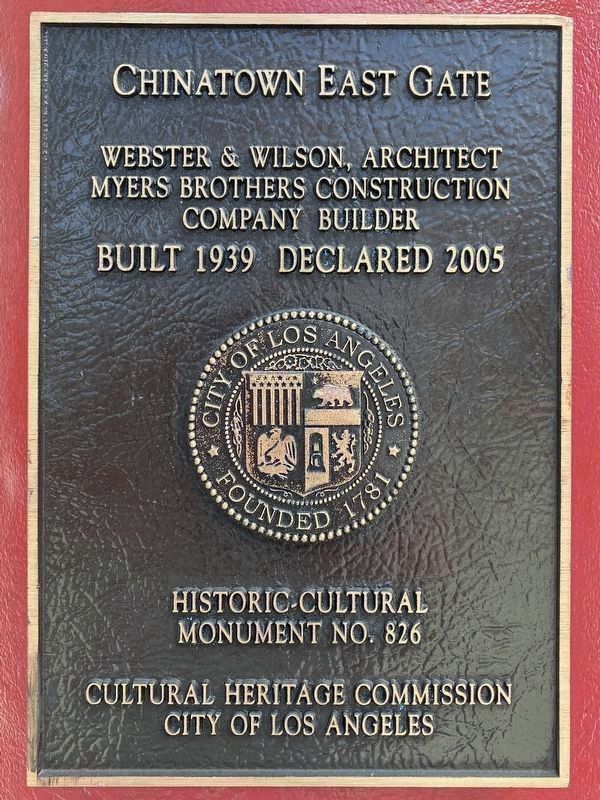Chinatown in Los Angeles in Los Angeles County, California — The American West (Pacific Coastal)
Central Plaza
Chinatown
— East Gate —
Chinatown Redefined
In 1933, when Old Chinatown was torn down to make way for the construc tion of Union Station, everyone began to think about what form a new Chinese community might take. Peter Soo Hoo, the first Chinese hired by the Depart. ment of Water and Power as an engineer, envisioned a Chinatown where the inhabitants could redefine themselves to the larger community. The buildings would be built strictly to code, the streets would be wide, open. and airy, and prostitu tion, gambling and opium would be forbidden. But the where and the how - when Chinese were unable by law to become naturalized citizens or own land in California - seemed insurmountable obstacles.
On April 22, 1937, Peter Soo Hoo arranged a meeting between Herbert Lapham, a sympathetic Santa Fe Railroad agent, and prominent Old Chinatown families to form the Los Angeles Chinatown Project Association. With Lapham's assistance, people purchased railroad land for 75 cents a square foot through their native-born - and thus American citizen - children. Erle Webster and Adrian Wilson, both Caucasians, were hired as architects. They designed what is believed to be one of the first outdoor malls in America.
On June 25, 1938, New Chinatown opened amidst great fanfare. Lanterns, banners, and flags of the United States and the Republic of China festooned the area. Maidens, dressed in traditional costumes, guided visitors through red-carpeted streets that had been given such topical names as Mei- Ling Way (the given name of Madame Chiang Kai-shek) and Sun Mun Way (for Dr. Sun Yat-sen's Three Principles of the People). Artists like Tyrus Wong, Gilbert Leong, and Keye Luke (at that time also an aspiring actor) contributed paintings and sculpture for an exhibition. After a parade, lion dance, firecrackers, and musical interludes, the politicians and celebrities (including Governor Frank Merriam and actress Anna May Wong) retired to the newly relocated Man Jen Low Restaurant for dinner and dancing.
Neo-Chinese Architecture
New Chinatown is all about details: gaily painted balconies, luminous tile work, windows covered by ornately carved screens in geometric patterns, and sweeping upturned roofs - many of which are decorated with additional sculptures of mythical animals. But Chinatown's most recognizable architectural elements are the four gates that grace the area. In China, gates are both practical and ceremonial, serving as entrances but often as commemorative memorials as well. Central Plaza's East Gate - or Gate of Maternal Virtues - was commissioned as an expression of filial piety by pioneer attorney You Chung Hong to honor the memory of his mother and all mothers.
Father of Modern China
Just inside the East Gate is a statue of Dr. Sun Yat-sen, Chinese revolutionary. ideological father of modern China, and first president of the Republic of China. He also had significant ties to Los Angeles. In 1905, Dr. Sun was smuggled into Southern California on a potato boat. He was honored at a fundraising banquet in Old Chinatown, and he exhorted young men to join his quest in the Plaza at El Pueblo. Eventually, over 2,000 troops would be smuggled out of this country and into China where they fought for the overthrow of the Manchu government and the formation of the Republic of China in 1911.
Homer Lea, a non-Chinese Los Angeles High School graduate, played a major role in these events. He had gone to China at the end of the 19th century, returned with a commission as a lieutenant general in the Chinese Imperial Reform Army, and formed the Western Military Academy to train officers for the future revolutionary army of China. Lea drilled hundreds of smartly uniformed young Chinese on streets in several communities in the state. In Los Angeles, his cadets went on field trips to Malibu, held maneuvers in the Hollywood Hills, and engaged in rifle practice at Laguna Beach.
Erected by City of Los Angeles. (Marker Number 826.)
Topics and series. This historical marker is listed in these topic lists: Architecture • Asian Americans • Settlements & Settlers. In addition, it is included in the Los Angeles Historic-Cultural Monument series list. A significant historical year for this entry is 1937.
Location. 34° 3.921′ N, 118° 14.216′ W. Marker is in Los Angeles, California, in Los Angeles County. It is in Chinatown. Marker is on Broadway north of College Street, on the left when traveling north. Touch for map. Marker is at or near this postal address: 947 N Broadway, Los Angeles CA 90012, United States of America. Touch for directions.
Other nearby markers. At least 8 other markers are within walking distance of this marker. Dr. Sun Yat-Sen (a few steps from this marker); Bruce Lee Statue (within shouting distance of this marker); Sun Mun Way (about 300 feet away, measured in a direct line); West Gate (about 400 feet away); Chinatown Heritage and Visitor Center (about 600 feet away); Pacific Alliance Medical Center (about 700 feet away); Castelar School (approx. 0.2 miles away); Cathay Bank (approx. ¼ mile away). Touch for a list and map of all markers in Los Angeles.
Also see . . . Angels Walk L.A. Self-guided walking tours of historic neighborhoods in Los Angeles. The East Gate marker is part of the Chinatown walk. (Submitted on April 6, 2023.)
Credits. This page was last revised on April 6, 2023. It was originally submitted on April 6, 2023, by Craig Baker of Sylmar, California. This page has been viewed 132 times since then and 46 times this year. Photos: 1, 2, 3, 4. submitted on April 6, 2023, by Craig Baker of Sylmar, California.



